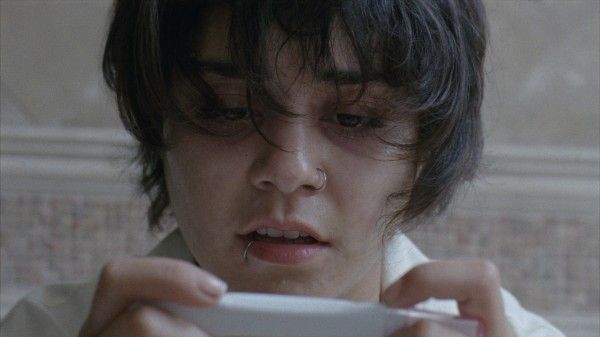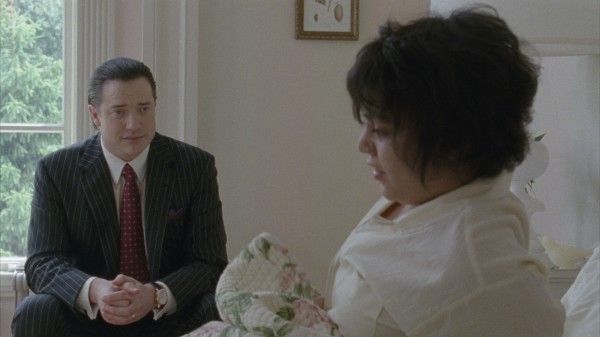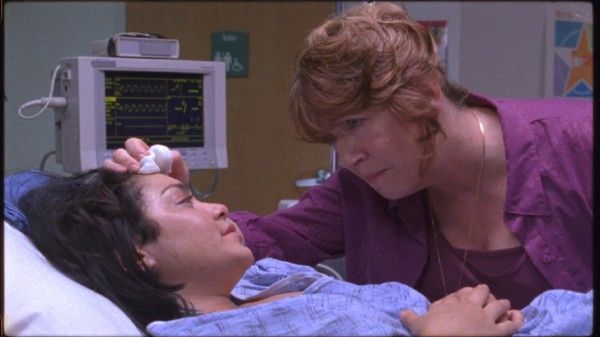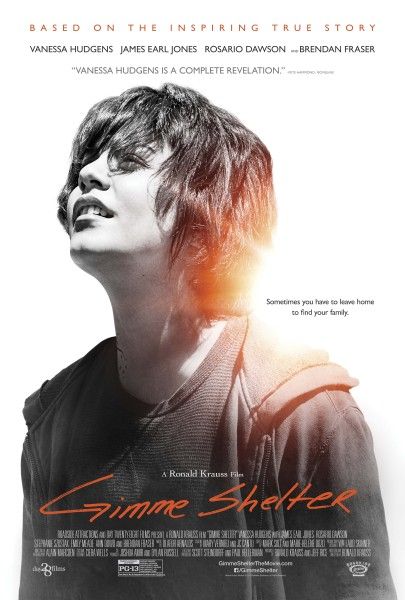Whether making documentaries or narrative films, Ron Krauss’ focus has always been on reflecting real-life issues with compassion, hope and authenticity. When his recent project, Amexica, a devastating drama about human trafficking, was screened at the United Nations, Krauss unexpectedly discovered the subject of his next film, Gimme Shelter. There he was introduced to Kathy DiFiore, a remarkable woman who was being honored at the UN for her work with teenaged mothers. Formerly homeless, DiFiore managed to put her life back together before founding Several Sources Shelters, a network of resources devoted to helping women in need.
At the recent press day for the film, Krauss and DiFiore talked about what inspired their collaboration, how he was intrigued by her work and arranged to visit one of her shelters, the casting process and why he chose Vanessa Hudgens to play the film’s central character, how Krauss spent time at DiFiore’s shelter and found it a profound and life-altering experience to witness first-hand how lives were changed through her work, and why DiFiore considers Gimme Shelter a legacy film. Krauss also revealed that his next project will be once again a human interest story that inspires people. Hit the jump to read the interview.
QUESTION: Kathy, what did you think when this guy showed up on your doorstep?
KATHY DiFIORE: Usually they’re pregnant women.
How did you feel when he proposed the idea of doing a movie based on your shelter?
DiFIORE: It didn’t happen that way. He was visiting his brother who happens to live a mile and a half from the shelter, and he had heard about my work through a friend of a friend of a friend of a friend, and he volunteered. It was Christmastime. I let people come in to volunteer certainly all the time, especially somebody that has the talents that he has. He eventually said, “Maybe I could film some of what you’re doing,” which I wasn’t fond of because of the $10,000 fine. I didn’t want any publicity. I just wanted to go quietly [about my business] with no public relations. Over the course of time, it took several months as he was doing the work, as he was speaking with the young mothers, and they got to know him. They would come to me, and they would tell me how much they respected him, and how much he respected them, and that they felt that they were giving him private information, but he was treating them with such dignity. You don’t usually hear those types of words coming out of the young women that come to me. They’ve been abused and abandoned and really are confused, particularly by the men in their lives. And then, I heard a little voice inside my head. I’m a very prayerful woman and I was asking God for guidance, and I heard, “Trust him.” When I heard, “Trust him,” and it kept going on, I thought, “Okay, Holy Spirit. Okay.” And then, he and I talked about some of the things that he looked at. At that point, I was starting to trust him.
Ron, can you talk about how this project came together for you?
RONALD KRAUSS: I didn’t really have any sort of agenda when I met Kathy. I wasn’t really setting out to make a film. It just so happened that her shelter was a mile from my brother’s house and it was at Christmastime. Usually during the holidays, like a lot of people, I’m at food banks or shelters just reaching out to people less fortunate. I remember the first time I was there visiting Kathy and I walked into that shelter, I saw mothers and children walking around. It was really fascinating. It’s exactly what you see in the film because we shot the film in the real place. I had learned that Kathy had not done any publicity in her work for the last 30 years. She remained anonymous other than when she started with the $10,000 fine. That was news of a woman who was homeless and was trying to give back to society by turning her own home into a shelter, and the state came down on her, and that’s a whole other story. I don’t know if you’re familiar with that story or not. She reached out to Mother Teresa, and Mother Teresa came by her side, and together they changed the laws in the state of New Jersey, and she was honored in the White House by President Ronald Reagan.
I had learned all this which was fascinating, and I was intrigued by her. But I was even more intrigued by the young women that struggled and were finding their way in life and how Kathy was selflessly helping them with her work in this shelter and the five shelters that she has now, some just for homeless women and some for teenagers and different things. My first objective was to really help her organize so that her legacy and her work would continue. I didn’t realize that I was planting the seeds for a film. I was trying to say that people need to learn about your work. At first, I was thinking that I was going to document her work with any device that I found there, just for her own purpose so people could find out later. I actually borrowed her camera, and I started to interview and record the girls and go through her boxes and look at all her old videotapes and a lot of stuff. I started filming one girl after the next, interviewing them, asking them where they were from, how they ended up here, where were their parents, and all these things. The tapes started piling up. I would put them in Kathy’s office in the back and before I knew it, there was a whole stack of tapes of these girls and their stories, and they were all very similar.
They were all stories of abuse and neglect and abandonment. It was either something like a bad mother, a bad father, and nobody cared. The thing they had in common was that they didn’t pick this life. They didn’t pick these parents. They didn’t pick a parent who was a drug addict or an alcoholic. It just happened. What do people do when these things happen? They just get abused, and they struggle in life, and they think there’s no hope. A lot of times, the will of the parents and the people who are bad gets thrown onto these kids, and they become angry and bitter, and they fight and they rebel, and they run away and they become homeless. And so, it’s a vicious cycle. I think the turning point of the whole thing for me was I kept coming back, and weeks were passing, and people’s lives were passing through my life. They were touching me, but I was a little bit removed in a sense.
Then, one day I showed up at the shelter at about 7:00 o’clock one night, and there was a young girl standing there in front of the shelter. She was an African American girl who was about 18 years old. It was about 15 degrees out, and she had no jacket on, and she was just standing there. I said, “Can I help you? Why don’t you come inside? What are you doing out here?” I thought she lived in the shelter but she didn’t. She thought I worked there and I didn’t. And so, we were both misleading each other. Then Kathy showed up and we were standing there. I was standing in the living room with this girl. Kathy said, “Who’s this girl?” and I said, “I don’t know. She was in front of the shelter.” She said, “C’mere.” I walked over to her and she said, “Never let anybody into the shelter. These are the rules here.” She dug into me a little bit. I was like, “Okay, but this girl doesn’t have any place to go. She’s by herself. She doesn’t have a jacket. She has nothing.” And she said, “Let me talk to her.”
Kathy is very seasoned, obviously, and knows what to look for in these people because they can be deceiving. She interviewed her, and she came back to me and she said, “It just so happens we have one bed left in the shelter. Why don’t you tell this girl that she can stay here?” Her name was Darlicia. And so, I went up to her and I said, “Hey Darlicia, they have an extra bed for you to stay. You can stay here.” This girl hugged me so hard that she almost knocked me over.
Was Darlicia the one that you based Vanessa Hudgen’s character on?
KRAUSS: Yes. It sent a jolt into my heart about the fact that there are many young girls like this out there that could use help. That’s what inspired me creatively and made me think that if I was to make a film, it could create awareness for other people. I asked Kathy about it, and of course, she said, “Absolutely not.” And then, time went on, and she came to me and said, “The girls really respect you and trust you in terms of the care of what you’ve been doing. Perhaps you’re right. Maybe some sort of film could really help to spread the word that shelters like this exist and that other people can be kind. Maybe someone will open a shelter if they see a film like this.” But no one ever anticipated that it would be a film like this.
Why did you choose Vanessa for the central role and what was it like to work with her?
KRAUSS: I never thought that a Hollywood actress could play a role like this after living there for a year while writing the script. There were a lot of famous actors that wanted to do it and had auditioned, and some of them were really well known. And then, someone mentioned Vanessa Hudgens. I didn’t really know who she was. I met with her. She was very passionate about playing this role. She believed in herself, that she could really do it, and that there was something inside of her. She turned in a great audition. She was persistent. The turning point was that I had taken all the auditions. There were a few of them that I liked, maybe seven or eight, and I sent them to the shelter. I didn’t tell them who I was thinking about. When they saw the link of the girls, they unanimously picked Vanessa. They said, “This is the girl. This is the girl who should play this part.” That was the confirmation. Vanessa dove into this thing. She lived in the shelter. She cut her hair off. She gained 15 pounds. Besides the physical transformation, she transformed inside. She bonded with Kathy and the girls, and they trusted her and opened up to her.
Kathy, what did you think of the final film when you saw it?
DiFIORE: It was perfect. It more than portrayed [what we’re about]. It still makes me cry when I watch it. And I can’t wait. There are women that have left, several sources that want to come and see it, and I can’t wait for that. It’s a legacy film for us.
Ron, what are you working on next?
KRAUSS: Right now I’m just focused on this. I’ve been offered another film. I was going to start it, and then I really became very involved with this film, and I didn’t want to abandon this movie. I wanted to make sure that it had the proper understanding. So, right now, I’m just staying with this film until it comes out. I can guarantee that whatever I do next, it’ll be again something in the vein of human interest and a story that inspires people.





